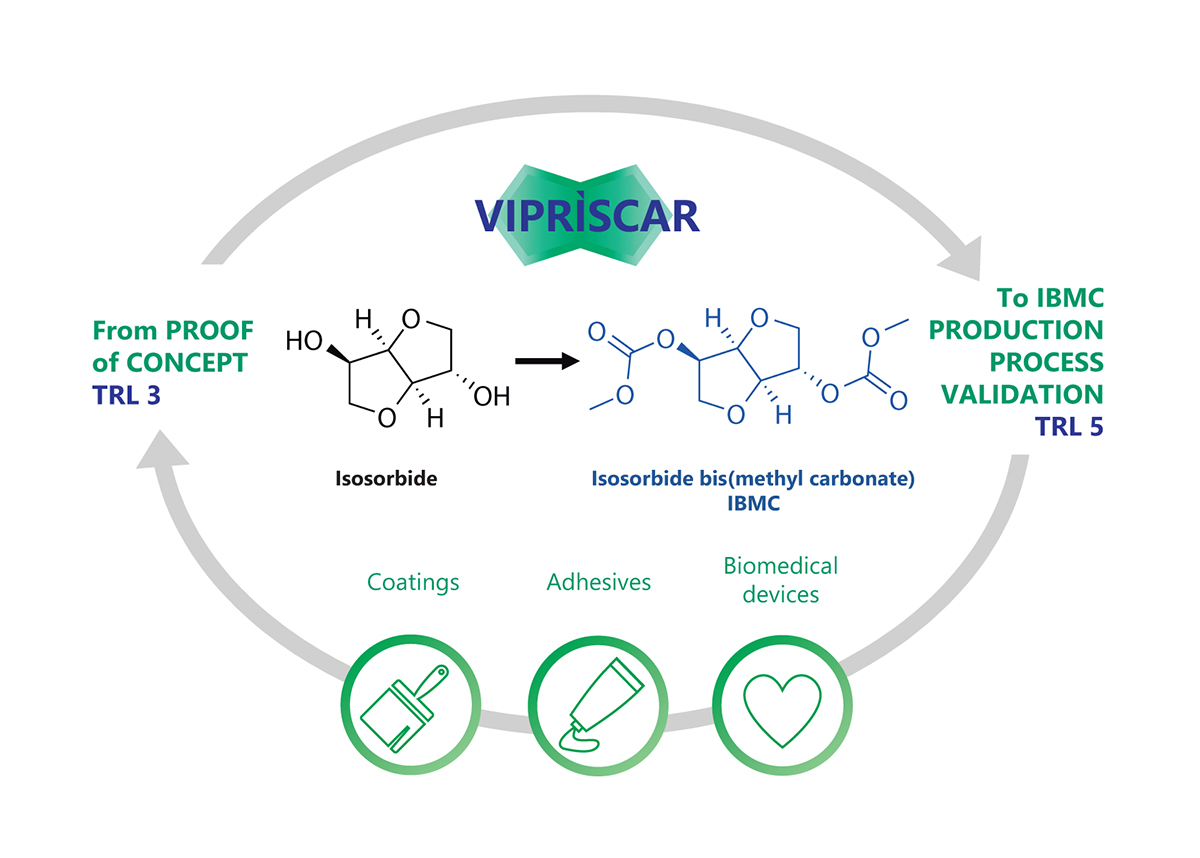Isosorbide bis(methyl carbonate) (IBMC) is a new business opportunity to comply with the European Green Deal, explains Dr Soraya Prieto-Fernández from TECNALIA, Basque Research and Technology Alliance
Climate change and environmental degradation are an existential threat to Europe and the world. Europe needs a new growth strategy that will transform the Union into a modern, resource-efficient and competitive economy, where:
There are no net emissions of greenhouse gases by 2050.
Economic growth is decoupled from resource use.
No person and no place are left behind.
The European Green Deal and the bioeconomy
To overcome these challenges, the European Union (EU) has established The European Green Deal a plan to make the EU’s economy sustainable. (1)
The European Green Deal provides an action plan (2) to:
Boost the efficient use of resources by moving to a clean, circular economy.
Restore biodiversity and cut pollution.
All of these are important because the EU aims to be climate neutral in 2050. Reaching this target will require action by all sectors of our economy, in that sense, the bioeconomy and bioenergy are key factors.
The bioeconomy is focused on reducing the dependency on limited fossil-based resources and ensuring healthy and secure food production and supply. By promoting sustainable production of renewable resources from land, fisheries and aquaculture, and their conversion into bio-based products and bio-energy. Bio-based industries are playing an important role in spurring sustainable growth and boosting Europe’s competitiveness by re-industrialising and revitalising rural and coastal areas.
Expanding the base of resources and technologies for the production of chemicals, fuels, energy, materials and compounds with application in different industrial sectors is recognised today as an urgent need, both by industries as well as by policy-makers around the world.
The creation of bio-based processes still faces several technological challenges, which need to be properly addressed and overcome to allow a broader implementation of these processes on a large scale. Joint efforts between academia and companies, as well as the integration of interdisciplinary knowledge, can lead to innovative solutions capable of impacting the economy, environment and society.
In this sense, to overcome these challenges, in 2014, the BBI-JU (Bio-based Industries Joint Undertaking) was established. With the funding of more than 120 projects, the partnership has de-risked investments, stimulated research and innovation, integrated economic actors along value chains and created new bio-based materials, driving unprecedented transformation in the sector.
The VIPRISCAR Project
An example of this is the VIPRISCAR Project. (3) This project aims to achieve new business opportunity through the validation of an industrial process to manufacture isosorbide bis(methyl carbonate) (IBMC) at the pilot level.
IBMC is a new currently not commercially available secondary bio-based building block with high potential for creating new value chains in three key high-volume industrial markets for human beings’ welfare: i) industrial coatings; ii) adhesives; and c) biomedical applications. As well as creating also new cross-sector interconnections with bio-resource sectors, such as forestry, timber industry and so on. In other words, VIPRISCAR ambition is to pave the way for introducing into the market a new secondary bio-based chemical, IBMC, with structure and properties that make it a very promising candidate to substitute current oil-derived chemicals – such as Methylene diphenyl diisocyanate (MDI) and Toluene diisocyanate (TDI), in the manufacturing of polyurethanes (Pus) and polycarbonates – decreasing in this way the EU oil dependence and helping to boost a healthy and sustainable economy.
The three-year project objectives are: To improve the IBMC manufacturing process from TRL 3 to TRL 5; demonstrate a proof of principle of IBMC applications (coatings, adhesives and catheters); and deliver an economic feasibility study, a Life Cycle Assessment (LCA) and complying with REACH regulations.
IBMC is obtained from Isosorbide which is a non-toxic biomass-derived chemical currently obtained by a double dehydration of sorbitol (4) which, in turn, is industrially synthesized by hydrogenation of glucose resulting from polysaccharides such as starch and cellulose. (5) Its synthesis by transesterification of isosorbide with dimethyl carbonate (DMC) using homogeneous catalysts consisting of nitrogenated bases and superbases in order to avoid the presence of small amounts of acidic impurities in isosorbide. (6) Almost 200 kg of IBMC has been obtained with a yield proven to exceed 95% and with a DMC recovery of up to 90%, which makes the process economically and environmentally efficient.
Environmentally friendlier approaches
With an impending European ban on the use of isocyanates, there is an emerging interest to find environmentally friendlier approaches towards non-isocyanate polyurethanes (NIPUs). (7) Isocyanates, used in polyurethanes synthesis, raise severe health hazard concerns. Therefore, there is a growing demand for environment-friendly processes and products, especially solvent-free and isocyanate-free formulations.
In this sense, IBMC has been explored to produce non-isocyanate polyurethane (NIPU) coatings for the furniture sector, NIPU dispersions as adhesives and coatings for catheters with antibacterial and antithrombotic properties using IBMC-based NIPUs, obtaining very promising results.
In conclusion, it can be said that it is possible to create new value chains that include the synthesis of new molecules with no fossil-based counterpart and its applications in several impactful market sectors.
References
(1) https://ec.europa.eu/info/strategy/priorities-2019-2024/european-green-deal_en
(2) https://eur-lex.europa.eu/legal-content/EN/TXT/?qid=1596443911913&uri=CELEX:52019DC0640#document2
(4) a) M. Rose and R. Palkovits, ChemSusChem, 2012, 5, 167-176; (b) C. Dussenne, T. Delaunay, V. Wiatz, H. Wyart, I. Suisse and M. Sauthier, Green Chem., 2017, 19, 5332–5344.
(5) J. R. Ochoa-Gómez and T. Roncal, Production of Platform Chemicals from Renewable Resources, ed. Z. Fang, R. L. Smith Jr and X. Qi, Springer Book Series – Biofuels and Biorefineries, Singapore, 2017, ch. 9, vol. 7, pp. 265–310.
(6) J. R. Ochoa-Gómez, L. Lorenzo-Ibarreta, C. Dineiro-García and O. Gomez-Jiménez-Aberasturi. RSC Adv., 2020, 10, 18728.
(7) Kreye O., Mutlu H., Meier, M. A. R. Sustainable routes to polyurethane precursors. Green Chem., 2013, 15: 1431-1455.
Acknowledgements
The VIPRISCAR project has received funding from the Bio-Based Industries Joint Undertaking (JU) under the European Union’s Horizon 2020 research and innovation programme under grant agreement No. 790440. The JU receives support from the European Union’s Horizon 2020 research and innovation programme and the Bio-Based Industries Consortium.
Please note: This is a commercial profile












